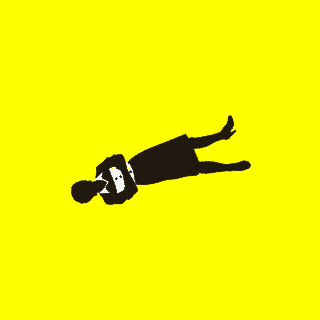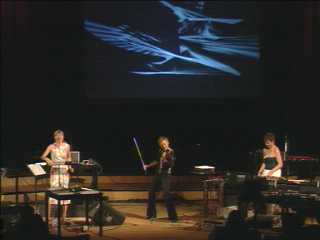I. radio comic #6: 220D
II. Colophony Circuit trifft auf Dorit Chrysler in einem "Hörspielkonzert"
A CASSETTE OF THIS PROGRAM CAN BE ORDERED FROM THE
"ORF
TONBANDDIENST"

Radiocomic #6
220D
von Josef Klammer und Albert Pall
 PLAY
PLAY
http://stream.mur.at:8000/kunstradio/mp3/2004B/MP3/14_11_04.mp3
|
[ English Version ] Die sechste Folge der Radiocomics, "220D", markiert vorläufig das Ende dieser von Josef Klammer und Albert Klammer gestalteten Reihe. Über das Jahr 2004 verteilt, verbanden die Radiocomics Text und Musik höchst individuell, in gegenseitiger Ergänzung und Irritation. Wo der Beobachter die Textur einer Handlung zeichnet, vergrössert die Musik latente akustische Ereignisse. Die Parallelen treffen sich im Radio. Text: Albert Pall Aufgenommen live in Schrattenberg / hotel pupik [ Deutsche Version ] The sixth radio comic, "220D", marks the preliminary end of this series created by Josef Klammer and Albert Pall. Text: Albert Pall |

RE-INVENTING RADIO Part II: The Long Night of Radio Art
Colophony Circuit trifft auf Dorit Chrysler in einem "Hörspielkonzert"
Ein Stück für Theremin, E-Violine, Synthesizer und drei Stimmen
von Dorit Chrysler, Electric Indigo und Mia Zabelka
 PLAY
PLAY
http://stream.mur.at:8000/kunstradio/mp3/PROJECTS/REINVENTING/rkhaus/colophonycircuit.mp3
|
[ English Version ] Speziell für die Lange Nacht der Radiokunst am 3. September entwickelten die Musikerinnen Dorit Chrysler (Theremin), Electric Indigo (Synthesizer) und Mia Zabelka (E-Violine) ein sogenanntes "Hörspielkonzert" und traten erstmals gemeinsam auf. Schon zuvor haben Electric Indigo und Zabelka unter dem Namen "Colophony Circuit" mit Sound und Musik experimentiert, wobei sie als "menschliche Rhythmusmaschinen" im Duo Melodien kreieren und Geräusche zu Musik werden lassen. Das "Hörspielkonzert", das die Musikerinnen einem Motto der Langen Nacht entsprechend mehrkanalig in 5.1 produzierten und sendeten, fokussiert unterschiedliche Aspekte des Mediums Radio: die Künstlerinnen spielten mit alten und neuen Technologien, natürlichen und artifiziellen Werkzeugen; die formale Gestaltung der Performance als Hörspiel-Variation nimmt auf ein unverzichtbares Genre des Mediums Bezug. Mit den neuen Möglichkeiten eines, dank der 5.1 Mehrkanal-Sendetechnik räumlich konzipierten und wahrzunehmenden Radios spielte Mia Zabelka. Die Künstlerin setzte ihre Bewegungen, die hörbar in die Live-Improvisation einflossen mittels des eigens für sie entwickelten SOMO-Systems kreativ um; die "Sound Motion"-Technik bietet der Künstlerin die Möglichkeit, durch ihre Bewegung(en) die Position eines von ihr erzeugten Sounds im (Radio-)Raum zu beeinflussen: je nach Kodierung korreliert die Wiedergabe der Sounds auf einer Mehrkanal-Soundanlage mit den räumlichen Bewegungen Zabelkas. Chrysler wiederum dringt mit dem eigenen Körper in das elektromagnetische Feld des Theremins ein und erzeugt dadurch, ohne jemals mit dem Instrument direkt in Berührung zu kommen, die unterschiedlichsten Klänge; durch die räumliche Annäherung an diesen Tongenerator konnten auch ihre Mitspielerinnen den Sound beeinflussen. Chrysler verwendete aber auch Loops und Delay-Effekte, die die Erzählung des Hörspiels rhythmisch strukturierten. Zu den Interaktionen der Künstlerinnen und zur choreographierten Gestaltung des Sounds stellt sich auch eine sprachlich-textliche Ebene, die ein Verweis auf das Genre des Hörspiels darstellt: professionelle Regieanweisungen, Kommentare und assoziative Textschleifen ergänzen, erweitern, überlagern die Improvisation um eine neue, eigenständige Ebene. Für die Ausstrahlung des Stücks in der wöchentlichen Kunstradio-Sendung haben die Künstlerinnen eine eigene Stereo-Version abgemischt. [ Deutsche Version ] Especially for their first ever performance together during the the Long Night of Raido Art on September 3rd, 2004, Dorit Chrysler (theremin), Electric Indigo (synthesizer), and Mia Zabelka (e-violin) developed a so-called "radio play concert". Previous to this event, Electric Indigo and Mia Zabelka have performed together under the label "Colophony Circuit", experimenting with sound and music, using their whole bodies as "human rhythm machines" to create melodies, transforming sound and noise into music. The "radio play concert", produced and broadcast in a multi-channel modus due to a motto of the Long Night of Radio Art, focuses on various aspects of the radio: the artists played with old and new technologies, natural and artificial tools; the idea to sketch out the performance as variation of a radio play refers to an essential genre of the medium radio. Thanks to 5.1 multi-channel broadcast technologies, Mia Zabelka played with the possibilities of a spacially designed and perceivable radio. The artist creatively transformed her own motions, using an individually and exclusively developed motion-tracking system called SOMO, and audibly implemented these in her live improvisation; this "Sound-Motion"-technology offers the artist the opportunity to control the position of a sound produced by herself within (radio) space only by means of her own moves: According to the code, the reproduction of the sounds on a multi-channel sound system correlates with the artist's motions in space. On the other hand, Dorit Chrysler intrudes the electro-magnetical field of the theremin with her body and thus, without ever touching the instrument, produces different sounds; also her collegues can interact with this sound generator merely by means of spacial approximation. Chrysler also uses loops and delay effects which structure the narration of the radio play in a rhythmical way. Finally, a linguistic-textual level - a reference to the genre of the radio play - completes the artistic interactions and choreographed sound design: professional directing instructions, comments, and associative text loops complete, expand, superpose the improvisation, creating a new, independent layer. For the weekly broadcast, the artists have mixed a special stereo version of their piece. |
[TOP]